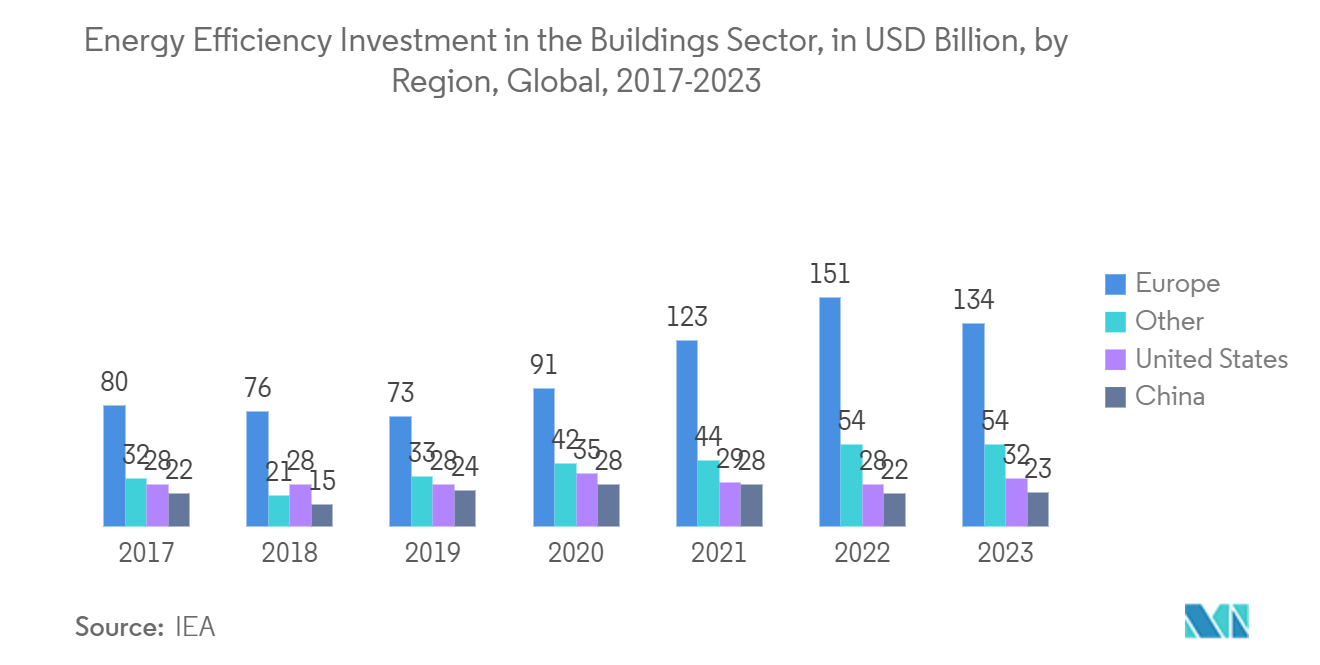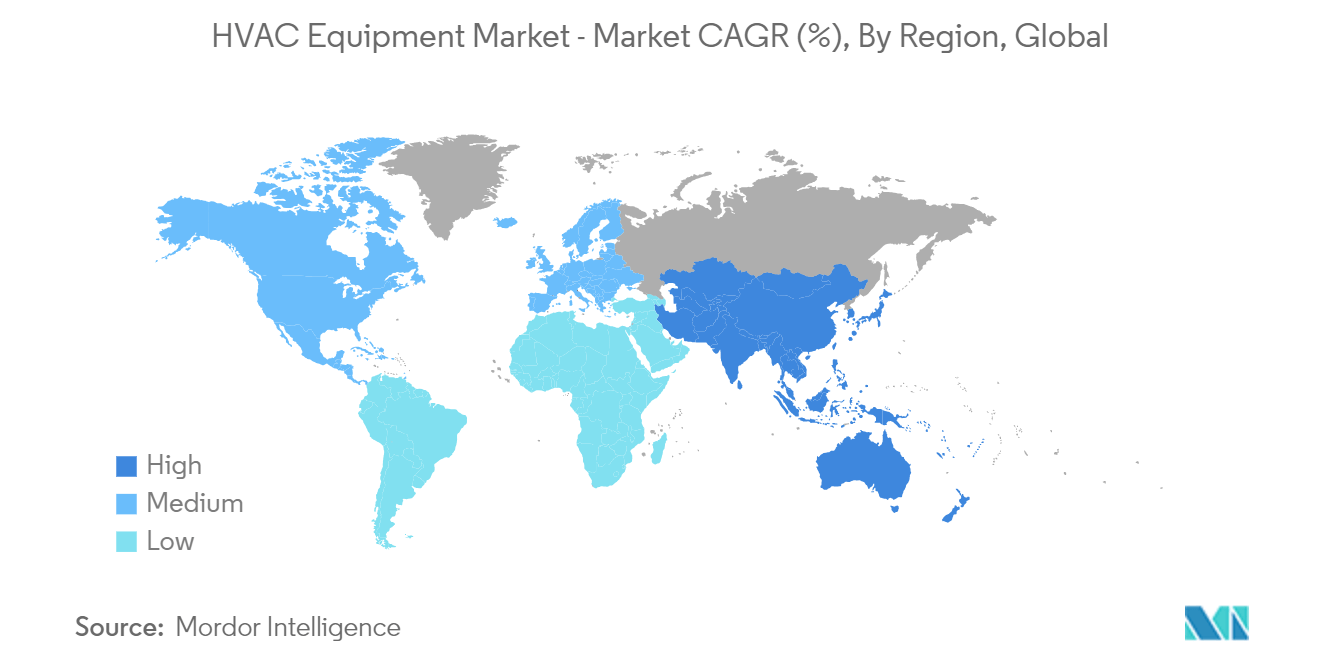Market Trends of HVAC Equipment Industry
Heat Pumps to Drive the Heating Equipment Segment
- A heat pump is a significant HVAC equipment that utilizes work to transfer heat from a colder area to a hotter area by transferring thermal energy through a refrigeration cycle. This process cools the colder area while warming the hotter area. During chilly weather, a heat pump can extract heat from the cold outdoors to warm a house. Conversely, in warmer weather, the pump can be designed to transfer heat from the house to the warmer outdoors. Due to their ability to transfer heat instead of generating it, heat pumps are more energy-efficient compared to alternative methods of heating or cooling a residence.
- Heat pumps provide a highly efficient option to traditional furnaces and air conditioners in any climate. Similar to refrigerators, heat pumps utilize electricity to transfer heat from a colder area to a warmer area, resulting in a cooler cold space and a warmer warm space. The efficiency of a heat pump is measured by its coefficient of performance (COP) or seasonal coefficient of performance (SCOP). A higher number indicates a greater level of efficiency for the heat pump. Regarding space heating, heat pumps generally outperform electric resistance heaters and other types of heaters regarding energy efficiency.
- Due to their exceptional efficiency and the growing proportion of renewable energy sources in power networks, heat pumps have the potential to significantly contribute to mitigating climate change. The escalating need for environmentally friendly heating and cooling systems that offer superior energy efficiency is driving the widespread adoption of heat pumps. These pumps attract demand from end users by reducing costs, conserving energy, and operating with remarkable efficiency. The increasing global awareness of the importance of reducing greenhouse gas emissions further fuels the demand for heat pumps.
- The demand for heat pumps is poised to experience growth driven by the growing need for energy-efficient solutions and various factors, including government initiatives to reduce carbon emissions. In achieving net zero emissions by 2050, high-efficiency electric heat pumps are expected to be the key technology in reducing heating emissions in the construction industry. The International Energy Agency (IEA) predicts that by 2030, approximately 600 million heat pumps could be installed globally, and the value of investments in energy-efficient buildings in 2023 was higher in Europe than in other regions. Investments for that market in China are approximately USD 23 billion, lower than in the United States. These investments are necessary to reduce the environmental impact of buildings, as they are responsible for a significant share of global greenhouse gas emissions.
- Nevertheless, the International Energy Agency (IEA) has emphasized that despite their benefits, heat pumps currently only fulfill approximately 10% of the world's heating requirements in buildings. To align with the Net Zero Emissions by 2050 (NZE) scenario, the global heat pump inventory must nearly triple by 2030, providing coverage for at least 20% of the global heating demand. Consequently, governments of various nations are prioritizing the installation of energy-efficient heat pumps by offering subsidies, which has resulted in a significant surge in consumer demand. These heat pumps not only enhance efficiency but also contribute to the reduction of carbon emissions, thereby expanding their market presence.
- For instance, in early 2023, France, the United States, Ireland, and Austria followed suit by raising subsidy levels, establishing a solid groundwork for the widespread adoption of heat pumps. Concurrently, continuous research and development endeavors yield cutting-edge heat pump technologies that boast enhanced efficiency and cater to end users' specific needs. Manufacturers diligently craft dependable and economical heat pumps to fulfill consumers' aspirations. Furthermore, according to IEA, in the years 2022 and early 2023, several prominent manufacturers, primarily based in Europe, unveiled their expansion strategies that, if fully implemented, would result in a more than 30% increase in global manufacturing capacity. However, to align with the deployment goals outlined in the NZE Scenario, the existing global manufacturing capacity will have to quadruple by 2030.

Asia-Pacific Expected to Dominate the Heating Equipment Segment
- The Asia-Pacific region is expected to experience substantial growth due to increasing urbanization and rising disposable income. The boiler market in this region is expected to be boosted by the ongoing expansion of sustainable building projects and the achievement of zero-emission building targets. Furthermore, boilers for the industrial sector are anticipated to witness growth due to the rapid industrialization driven by consistent government initiatives to attract foreign direct investments (FDIs).
- The Asia-Pacific region, particularly India and China, is anticipated to experience a significant surge in demand for industrial boilers. These countries are rapidly emerging as global manufacturing hubs, and their large populations offer lucrative growth prospects for industries such as food and beverages, consumer goods, textiles, and more. This crucial factor is expected to drive the growth of the industrial boilers market in the Asia-Pacific region in the near future.
- In urban areas of northern China, coal-based district heating is currently the dominant solution for space heating. The traditional heating methods have profoundly impacted the lifestyles and cultural heritage of the Chinese people. However, a significant number of households in China still rely on small coal stoves for warmth, resulting in air pollution that poses health risks. To tackle these issues, the Chinese government initiated the "Clean Heating Plan" in 2017, aiming to shift 70% of households in the northern region away from coal and towards cleaner heating alternatives. As a result, China aims for carbon neutrality by 2060 and has engaged in a successful effort to reduce air pollution.
- Residential space heating has experienced remarkable growth in urban Southern China over the past ten years. The substantial rise in demand for space heating presents considerable sustainability challenges. Consequently, heat pumps have become increasingly popular in the region and are extensively utilized throughout China. Air- and ground-source heat pumps have successfully captured a significant portion of the market and are currently witnessing a surge in adoption. The Chinese government has played a crucial role in supporting this development by implementing various policies, including the coal-to-electricity project.
- China has the highest number of installers, as stated by the IEA. This is mainly because a significant portion of the building stock, especially in the country's southern region, utilizes heat pumps for both cooling during the summer and heating in the winter. Moreover, China has been actively working toward reducing its dependence on coal for domestic heating to enhance air quality. China and Europe are increasingly adopting heat pumps as part of its decarbonization plans. Over the past five years, China's reliance on coal for heating buildings has been cut in half, thanks to the government's implementation of various initiatives to subsidize electric heating.

